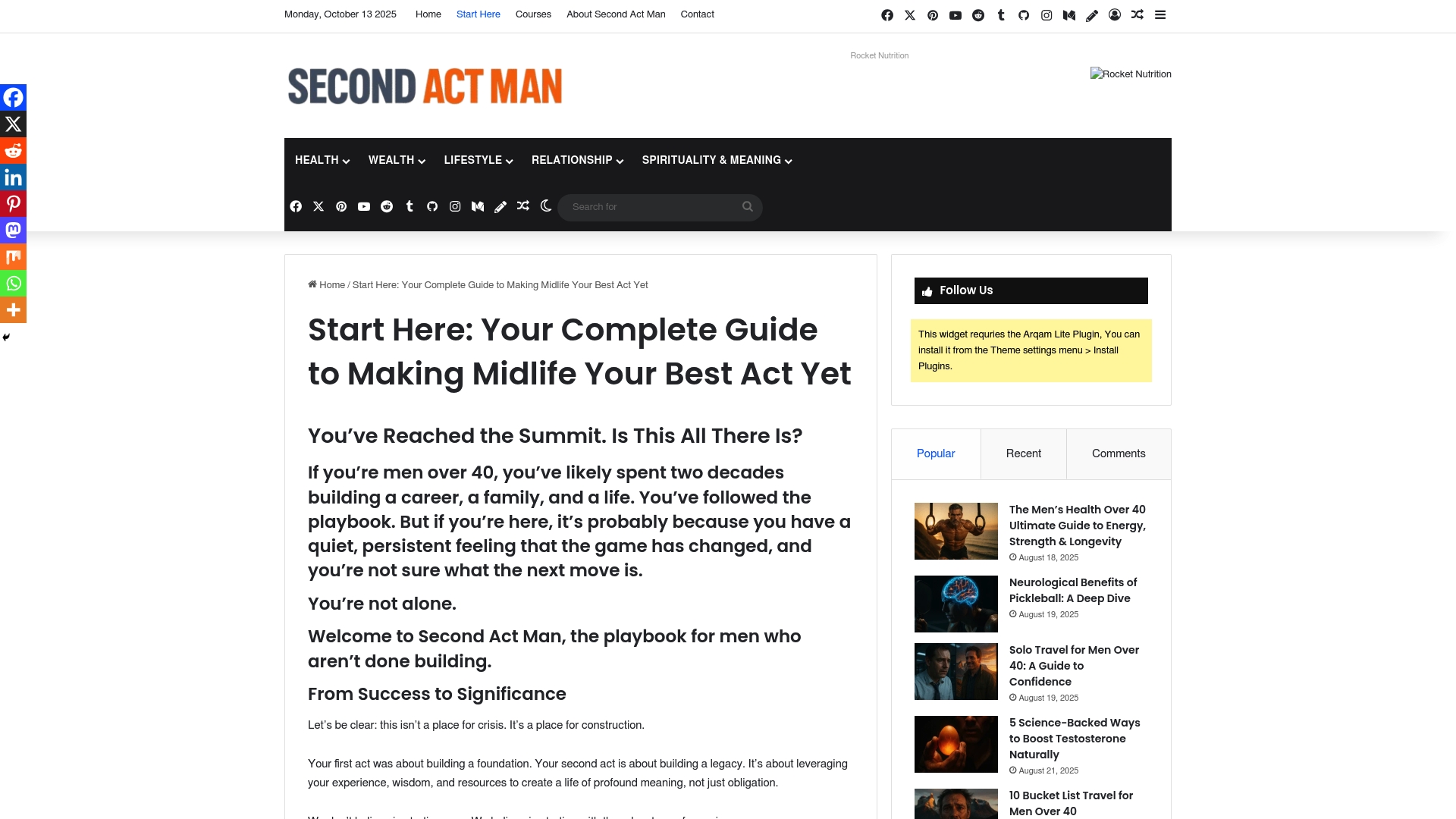Goal Setting Guide for Men Over 40: Achieve Lasting Change
Nearly 80 percent of people who set personal goals abandon them within the first few months. Real transformation takes more than wishful thinking. Knowing what truly motivates you and building a step-by-step plan can turn fleeting resolutions into real progress. If you want changes that last, it starts with understanding your core values and ends with daily actions that build momentum for growth.
Table of Contents
- Step 1: Identify Your Core Motivations And Values
- Step 2: Define Clear, Attainable Goals Aligned With Your Life Stage
- Step 3: Develop Actionable Plans And Set Milestones
- Step 4: Build Accountability And Secure Support
- Step 5: Track Progress And Adjust For Continued Growth
Quick Summary
| Key Point | Explanation |
|---|---|
| 1. Discover Your Core Values | Conduct a deep self-reflection to identify authentic motivations that drive your goals. |
| 2. Set SMART Goals | Create specific, measurable, achievable, relevant, and time-bound goals related to personal growth, professional development, and life experiences. |
| 3. Develop Action Plans | Break down goals into manageable steps with clear milestones to facilitate consistent progress and accountability. |
| 4. Build a Support Network | Surround yourself with encouraging individuals who check in on your progress and provide constructive feedback. |
| 5. Regularly Track Progress | Engage in monthly reviews to celebrate achievements, reflect on challenges, and adjust your strategies as needed. |
Step 1: Identify Your Core Motivations and Values
Unlocking authentic personal transformation starts with understanding your deepest motivations. This step will help you dig beneath surface level goals and connect with what truly drives you forward.
According to Shalom H. Schwartz’s theory of basic human values, human motivations are universal yet deeply personal. Your task now is to conduct an honest self-inventory that reveals your authentic drivers.
Start by creating quiet space for reflection. Grab a notebook and ask yourself powerful questions: What moments in my life made me feel most alive? When have I felt profound sense of purpose? What activities make time disappear?
Look for patterns in your answers. These reveal core values like personal growth, connection, contribution, or adventure. Building inner strength requires understanding these fundamental motivational blueprints.
As research from wellness experts suggests, developing emotional intelligence means being brutally honest with yourself. Avoid the trap of writing what you think you should want. Write what genuinely resonates.
Quick warning: Do not rush this process. Values are not static billboards but living, evolving landscapes of personal meaning. Give yourself permission to explore without judgment.
In the next step, you will transform these insights into actionable goals that align with your newly discovered core motivations. Get ready to chart a path that feels authentically yours.
Step 2: Define Clear, Attainable Goals Aligned With Your Life Stage
Now that you understand your core motivations, it is time to transform those insights into strategic goals that match your current life landscape. This step is about crafting objectives that are meaningful, realistic, and perfectly calibrated to your midlife potential.
According to research from Chamberlain University, writing down goals helps visualize and commit to objectives appropriate for your current circumstances. Your goals should feel like a natural extension of your recently discovered core values.
Start by creating three categories of goals strategic personal growth, professional development, and life experience. In each category, draft goals that are specific, measurable, achievable, relevant, and time bound the classic SMART framework.
For personal growth, this might mean improving physical fitness, learning a new skill, or deepening emotional intelligence. Professional goals could involve career advancement, starting a side business, or transitioning into more meaningful work. Life experience goals might include travel, relationship building, or community engagement.
The Midlife Career Reinvention Playbook suggests that men over 40 should focus on goals that create genuine fulfillment rather than chasing external validation.
Warning zone: Avoid comparing your goals to others. Your path is uniquely yours. What works for one man might feel completely wrong for another.
In the next step, you will learn how to break these broad goals into actionable strategies that turn aspiration into reality. Prepare to transform your vision into a concrete roadmap for success.
Step 3: Develop Actionable Plans and Set Milestones
Turning your goals from abstract concepts into concrete reality requires strategic planning and deliberate action. This step is about breaking down your aspirations into manageable chunks that transform potential into progress.
Research from Brainz Magazine highlights the critical importance of building daily habits and surrounding yourself with supportive individuals. Your plan needs to be both flexible and structured.
Start by reverse engineering each goal. Take your big objectives and break them down into quarterly, monthly, and weekly milestones. For instance, if your goal is career reinvention, your milestones might include networking events, skill acquisition courses, resume updates, and informational interviews.
Create a visual tracking system. This could be a physical wall calendar, a digital spreadsheet, or a dedicated goal tracking app. Mark your milestones clearly and celebrate each small victory. The Deliberate Man Guide emphasizes that consistent tracking builds momentum and psychological confidence.
Recommend developing an accountability framework. This might mean partnering with a mentor, joining a professional group, or scheduling regular check ins with a trusted friend who understands your journey.
Warning zone: Perfectionism is the enemy of progress. Your plan will evolve. Expect detours and be ready to recalibrate without losing sight of your core objectives.
In the next step, you will learn how to maintain motivation and overcome inevitable obstacles that emerge during your transformation journey. Your roadmap is taking shape.
Step 4: Build Accountability and Secure Support
Successful personal transformation requires more than individual willpower. This step is about creating a robust support network that propels you toward your goals and keeps you anchored during challenging moments.
According to research from Brainz Magazine, surrounding yourself with supportive individuals who believe in your goals can provide crucial encouragement and accountability.
Start by identifying your core support team. This might include a professional mentor, a trusted friend, a career coach, or members of a men’s growth group. Look for people who challenge you constructively and genuinely want to see you succeed. Building inner strength means being vulnerable enough to seek guidance and support.
Consider creating multiple layers of accountability. This could mean a monthly check in with a mentor, weekly progress reports to a trusted friend, or joining an online community focused on midlife personal development. Diverse support channels provide different perspectives and motivation.
Be strategic about the type of support you seek. Some people are great listeners, others offer practical advice. Some can help you brainstorm, while others are excellent at holding you accountable. Match your support needs with the right individuals.
Warning zone: Not everyone in your current circle will understand or support your transformation. Be prepared to expand your network and potentially distance yourself from relationships that drain your energy or discourage your growth.
In the next step, you will learn how to maintain momentum and navigate inevitable setbacks with resilience. Your support system is your foundation for sustainable change.
Step 5: Track Progress and Adjust for Continued Growth
Personal transformation is not a linear journey but a dynamic process of continuous learning and adaptation. This step focuses on developing a reflective approach that keeps you moving forward with clarity and purpose.
According to Brainz Magazine, celebrating progress no matter how small helps maintain motivation and provides an opportunity to reflect on achievements and areas for improvement.
Implement a monthly review ritual. Set aside dedicated time to assess your milestones objectively. Ask yourself key questions: What worked well? Where did I encounter unexpected challenges? What skills or strategies do I need to develop further? The Midlife Career Reinvention Playbook suggests that honest self assessment is the cornerstone of meaningful personal growth.
Create a progress journal that tracks not just outcomes but your emotional and psychological journey. Document your wins no matter how modest. Did you attend a networking event? Learn a new skill? Complete a challenging task? These are victories worth acknowledging.
Be prepared to recalibrate your goals. Rigidity is the enemy of growth. Your initial plan is a starting point not a fixed destination. As you gain insights and encounter real world challenges, allow yourself the flexibility to modify your approach.
Warning zone: Avoid the trap of constant self criticism. Progress is rarely perfect. Some months will feel more productive than others. What matters is sustained forward momentum.
In the final step, you will learn how to integrate these strategies into a lifelong framework of personal development and continuous improvement.
Here’s a summary of each step in the transformation process:
| Step | Purpose | Key Actions |
|---|---|---|
| Identify Motivations & Values | Discover authentic drivers | Reflect deeply Look for life patterns Be honest with yourself |
| Define Goals | Align values with objectives | Draft personal, professional, and life goals Use SMART framework |
| Develop Action Plans | Turn goals into progress | Reverse engineer milestones Create tracking system Build daily habits |
| Build Accountability & Support | Strengthen commitment with allies | Identify support team Set check-ins Join communities |
| Track & Adjust Progress | Maintain momentum and adapt | Monthly reviews Record wins Recalibrate as needed |
Ready to Turn Your Goals Into Real Results After 40?
You have learned the keys to lasting change in the “Goal Setting Guide for Men Over 40”—from uncovering true motivations to crafting SMART goals and building support. But setting goals is just the beginning. If you have struggled to sustain momentum, felt stuck in midlife transitions, or wondered how to put your strategic plans into action, you are not alone. Many men over 40 want more than quick fixes. They need a trusted partner to help stay accountable, boost vitality, and navigate career or health changes. Explore practical tools for every area of your journey with Men’s Health Over 40: A Practical Guide to Fitness, Hormones & Vitality, and fuel your transformation with the right Nutrition for Men Over 40: Supplements & Meal Guide.

Experience the difference of a guided approach. Visit SecondActMan’s Start Here page to unlock expert resources for men navigating midlife transformation and take your next step with confidence. Make this chapter your strongest yet. Start now and see real change take hold.
Frequently Asked Questions
How can I identify my core motivations for goal setting?
To identify your core motivations, take time for self-reflection and ask yourself what moments in your life felt most fulfilling. Write down your answers to uncover patterns that reveal your authentic drivers; consider doing this over a week for deeper insight.
What are SMART goals, and how do I create them?
SMART goals are Specific, Measurable, Achievable, Relevant, and Time-bound objectives. To create them, start by articulating goals in these five areas for your life: personal growth, professional development, and life experiences, ensuring each goal meets these criteria for clarity and focus.
How can I break down my goals into actionable steps?
To break down your goals, reverse engineer each one by creating quarterly, monthly, and weekly milestones. Start with your larger objectives, then identify smaller tasks that you can take action on each week, making sure to track your progress regularly.
What role does accountability play in achieving my goals?
Accountability keeps you motivated and focused on your goals. Establish a support network, find a mentor or accountability partner, and schedule regular check-ins to discuss progress, ideally monthly, to keep your commitment strong.
How should I track my progress toward my goals?
To effectively track your progress, implement a monthly review ritual where you assess milestones and document wins, no matter how small. Create a simple progress journal where you can jot down your achievements and any challenges to adapt your approach as needed.
What should I do if I encounter obstacles during my transformation?
When encountering obstacles, be flexible and ready to recalibrate your goals without losing sight of your core values. Identify the specific challenges you’re facing, discuss them with your support team, and adjust your action plans to keep moving forward.
Recommended
- The Deliberate Man: A Guide to Intentional Living
- Best ED Treatments (2025): Top 4 Online Options Reviewed
- The Midlife Reboot: A Man’s Guide to Mastering the Second Act
- 12 Testosterone Boosting Foods for Men: A Guide for Midlife Vitality
- Setting Realistic Weight Loss Goals for Lasting Success – LeanAndFit
- How to Set Fitness Goals for Maximum Results – MyGymSupplements











